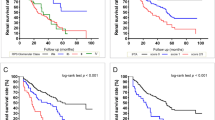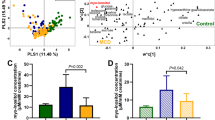Abstract
Hypertensive nephropathy (HN) requires a kidney biopsy as diagnostic gold-standard but histological findings are unspecific and specific prognostic markers are missing. We aimed at identifying candidate prognostic markers based on glomerular protein signatures. We studied adult patients (n = 17) with eGFR >30 ml/min/1.73m2 and proteinuria <3 g/d from the Norwegian Kidney Biopsy Registry, including subjects non progressing (NP, n = 9), or progressing (P, n = 8) to end-stage renal disease (ESRD) within an average follow-up of 22 years. Glomerular cross-sections from archival kidney biopsy sections were microdissected and processed for protein extraction. Proteomic analyses were performed using Q-exactive HF mass spectrometer and relative glomerular protein abundances were compared between P and NP patients. Immunohistochemistry (IHC) was used to validate selected data. Amongst 1870 quality filtered proteins, 58 were differentially expressed in P and NP patients’ glomeruli, with absolute fold changes (FC) ≥1.5, p ≤ 0.05. Supervised classifier analysis (K nearest neighbor) identified a set of five proteins, including Gamma-butyrobetaine dioxygenase (BBOX1, O75936) and Cadherin 16 (CDH16, O75309), overexpressed in P, and Eosinophil peroxidase (EPX, P11678), DnaJ homolog subfamily B member 1 (DNAJB1, P25685) and Alpha-1-syntrophin (SNTA1, Q13424), overexpressed in NP glomeruli, correctly classifying 16/17 kidney biopsy samples. Geneset Enrichment Analysis (GSEA), showed that metabolic pathways were generally enriched in P, and structural cell pathways in NP. Pathway analysis identified Epithelial Adherens Junction Signaling as most affected canonical pathway. IHC analysis confirmed overexpression of BBOX1 and Cadherin 16 in glomeruli from P patients. In conclusion, glomerular proteomic profiling can be used to discriminate P from NP HN patients.
This is a preview of subscription content, access via your institution
Access options
Subscribe to this journal
Receive 12 print issues and online access
$259.00 per year
only $21.58 per issue
Buy this article
- Purchase on Springer Link
- Instant access to full article PDF
Prices may be subject to local taxes which are calculated during checkout




Similar content being viewed by others
Data availability
Data are available via ProteomeXchange with identifier PXD026709.
References
Lusco MA, Najafian B, Alpers CE, Fogo AB. AJKD atlas of renal pathology: arterionephrosclerosis. Am J Kidney Dis. 2016;67:e21–2.
Reisaeter AV, Aasberg A. Annual Report 2020, The Norwegian Renal Registry (Norsk nyreregister); 2020;1–65. http://www.nephro.no/nnr/AARSRAPPORT_NNR_2020.pdf.
Hart PD, Bakris GL. Hypertensive nephropathy: prevention and treatment recommendations. Expert Opin Pharmacother. 2010;11:2675–86.
Kidney Disease: Improving Global Outcomes CKDMBDUWG. KDIGO 2017 clinical practice guideline update for the diagnosis, evaluation, prevention, and treatment of chronic kidney disease-mineral and bone disorder (CKD-MBD). Kidney Int Suppl (2011). 2017;7:1–59.
Paunas TIF, Finne K, Leh S, Marti HP, Mollnes TE, Berven F, et al. Glomerular abundance of complement proteins characterized by proteomic analysis of laser-captured microdissected glomeruli associates with progressive disease in IgA nephropathy. Clin Proteom. 2017;14:30.
Heslse direktoratet Norway, Guideline of the treatment of arterial hypertension 2018; Pages https://www.helsedirektoratet.no/retningslinjer/forebygging-av-hjerte-og-karsykdom/legemidler-ved-primaerforebygging-av-hjerte-og-karsykdom/legemiddelbehandling-av-hoyt-blodtrykk#752b5a70-98c1-4210-9ca0-4dda34751375-praktisk.
Wisniewski JR. Proteomic sample preparation from formalin fixed and paraffin embedded tissue. J Vis Exp. 2013;79:1–5.
Ikeda K, Monden T, Kanoh T, Tsujie M, Izawa H, Haba A, et al. Extraction and analysis of diagnostically useful proteins from formalin-fixed, paraffin-embedded tissue sections. J Histochemistry Cytochemistry. 1998;46:397–403.
Cox J, Mann M. MaxQuant enables high peptide identification rates, individualized p.p.b.-range mass accuracies and proteome-wide protein quantification. Nat Biotechnol. 2008;26:1367–72.
Cox J, Hein MY, Luber CA, Paron I, Nagaraj N, Mann M. Accurate proteome-wide label-free quantification by delayed normalization and maximal peptide ratio extraction, termed MaxLFQ. Mol Cell Proteom. 2014;13:2513–26.
Jarnuczak AF, Vizcaino JA. Using the PRIDE database and proteomexchange for submitting and accessing public proteomics datasets. Curr Protoc Bioinforma. 2017;59:13 31 1–13 31 12.
Deutsch EW, Bandeira N, Sharma V, Perez-Riverol Y, Carver JJ, Kundu DJ, et al. The ProteomeXchange consortium in 2020: enabling ‘big data’ approaches in proteomics. Nucleic Acids Res. 2020;48:D1145–D52.
Perez-Riverol Y, Csordas A, Bai J, Bernal-Llinares M, Hewapathirana S, Kundu DJ, et al. The PRIDE database and related tools and resources in 2019: improving support for quantification data. Nucleic Acids Res. 2019;47 :D442–D50.
Seccia TM, Caroccia B, Piazza M, Rossi GP. The Key Role of Epithelial to Mesenchymal Transition (EMT) in Hypertensive Kidney Disease. Int J Mol Sci. 2019;20.
Kalluri R, Neilson EG. Epithelial-mesenchymal transition and its implications for fibrosis. J Clin Invest. 2003;112:1776–84.
Paunas FTI, Finne K, Leh S, Osman TA, Marti HP, Berven F, et al. Characterization of glomerular extracellular matrix in IgA nephropathy by proteomic analysis of laser-captured microdissected glomeruli. BMC Nephrol. 2019;20:410.
Zhou LT, Lv LL, Qiu S, Yin Q, Li ZL, Tang TT, et al. Bioinformatics-based discovery of the urinary BBOX1 mRNA as a potential biomarker of diabetic kidney disease. J Transl Med. 2019;17:59.
Igarashi P. Following the expression of a kidney-specific gene from early development to adulthood. Nephron Exp Nephrol. 2003;94:e1–6.
Thomson RB, Dynia DW, Burlein S, Thomson B, Booth CJ, Knauf F, et al. Deletion of Cdh-16 Ksp-cadherin leads to a developmental delay in the ability to maximally concentrate urine in mouse. Am J Physiol Renal Physiol. 2021;320:F1106–22.
Dai DF, Sasaki K, Lin MY, Smith KD, Nicosia RF, Alpers CE, et al. Interstitial eosinophilic aggregates in diabetic nephropathy: allergy or not? Nephrol Dial Transpl. 2015;30:1370–6.
DeNichilo MO, Panagopoulos V, Rayner TE, Borowicz RA, Greenwood JE, Evdokiou A. Peroxidase enzymes regulate collagen extracellular matrix biosynthesis. Am J Pathol. 2015;185:1372–84.
Colon S, Luan H, Liu Y, Meyer C, Gewin L, Bhave G. Peroxidasin and eosinophil peroxidase, but not myeloperoxidase, contribute to renal fibrosis in the murine unilateral ureteral obstruction model. Am J Physiol Ren Physiol. 2019;316:F360–F71.
Bhat HF, Adams ME, Khanday FA. Syntrophin proteins as Santa Claus: role(s) in cell signal transduction. Cell Mol Life Sci. 2013;70:2533–54.
Jiang L, Hindmarch CC, Rogers M, Campbell C, Waterfall C, Coghill J, et al. RNA sequencing analysis of human podocytes reveals glucocorticoid regulated gene networks targeting non-immune pathways. Sci Rep. 2016;6:35671.
Park SY, Choi HK, Seo JS, Yoo JY, Jeong JW, Choi Y, et al. DNAJB1 negatively regulates MIG6 to promote epidermal growth factor receptor signaling. Biochim Biophys Acta. 2015;1853:2722–30.
Chebotareva N, Bobkova I, Shilov E. Heat shock proteins and kidney disease: perspectives of HSP therapy. Cell Stress Chaperones. 2017;22:319–43.
Sun HJ. Current opinion for hypertension in renal fibrosis. Adv Exp Med Biol. 2019;1165:37–47.
Mennuni S, Rubattu S, Pierelli G, Tocci G, Fofi C, Volpe M. Hypertension and kidneys: unraveling complex molecular mechanisms underlying hypertensive renal damage. J Hum Hypertens. 2014;28:74–9.
Maekawa H, Inagi R. Pathophysiological role of organelle stress/crosstalk in AKI-to-CKD transition. Semin Nephrol. 2019;39:581–8.
Zhang W, Sha Y, Wei K, Wu C, Ding D, Yang Y, et al. Rotenone ameliorates chronic renal injury caused by acute ischemia/reperfusion. Oncotarget 2018;9:24199–208.
Acknowledgements
We are thankful to Giulio Spagnoli, PhD, University of Basel, Switzerland, for correction of the manuscript and to Dagny Ann Sandnes for help with the immunohistological analyses as well as to Mohammad Ibrahim from our institution for his initial work of microdissection and sample preparation.
Funding
This work was supported by an open project grant (number F-12559) to Hans-Peter Marti and an open project grant (number 911968) to Bjørn Egil Vikse both from the Western Norway Regional Health Authority.
Author information
Authors and Affiliations
Corresponding author
Ethics declarations
Conflict of interest
The authors declare no competing interests.
Ethics approval
All patients provided written informed consent. The study was performed in accordance with principles of the Declaration of Helsinki and was approved by the Ethics Review Boards of the Universities of Bergen (REK vest 2013/553).
Additional information
Publisher’s note Springer Nature remains neutral with regard to jurisdictional claims in published maps and institutional affiliations.
Supplementary information
Rights and permissions
Springer Nature or its licensor holds exclusive rights to this article under a publishing agreement with the author(s) or other rightsholder(s); author self-archiving of the accepted manuscript version of this article is solely governed by the terms of such publishing agreement and applicable law.
About this article
Cite this article
Mikkelsen, H., Vikse, B.E., Eikrem, O. et al. Glomerular proteomic profiling of kidney biopsies with hypertensive nephropathy reveals a signature of disease progression. Hypertens Res 46, 144–156 (2023). https://doi.org/10.1038/s41440-022-01066-0
Received:
Revised:
Accepted:
Published:
Issue Date:
DOI: https://doi.org/10.1038/s41440-022-01066-0



